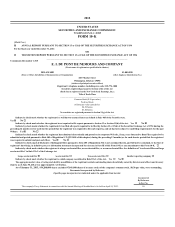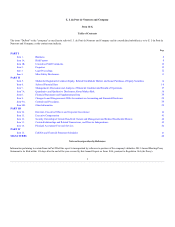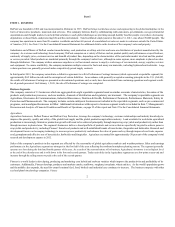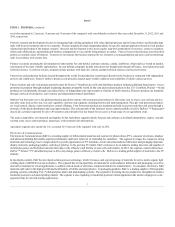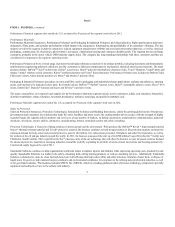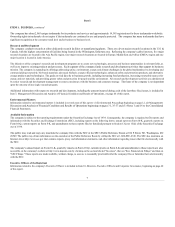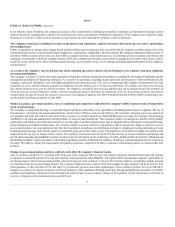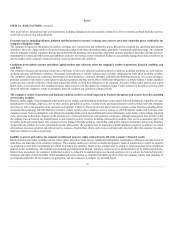DuPont 2012 Annual Report Download - page 7
Download and view the complete annual report
Please find page 7 of the 2012 DuPont annual report below. You can navigate through the pages in the report by either clicking on the pages listed below, or by using the keyword search tool below to find specific information within the annual report.
continued
Building Innovations is committed to the building science behind increasing the performance of building systems, helping reduce operating costs and creating
more sustainable structures. The business is a market leader of solid surfaces through its DuPont TM Corian® and Montelli® lines of products which offer
durable and versatile materials for residential and commercial purposes. Other products such as DuPont™ Tyvek ® and Typar® offer leading solutions for the
protection and energy efficiency of buildings.
The major commodities, raw materials and supplies for the Safety & Protection segment include: alumina hydroxide, benzene, high density polyethylene,
isophthaloyl chloride, metaphenylenediamine, methyl methacrylate, paraphenylenediamine, polyester fiber, terephthaloyl chloride and wood pulp.
Safety & Protection segment sales outside the U.S. accounted for 62 percent of the segment's total sales in 2012.
Pharmaceuticals
On October 1, 2001, DuPont Pharmaceuticals was sold to the Bristol-Myers Squibb Company. DuPont retained its interest in Cozaar® (losartan potassium)
and Hyzaar® (losartan potassium with hydrochlorothiazide), which are used in the treatment of hypertension. DuPont has exclusively licensed worldwide
marketing and manufacturing rights for Cozaar ® and Hyzaar® to Merck & Co., Inc. (Merck).
Pharmaceuticals' Cozaar®/Hyzaar® income is the sum of two parts: income related to a share of the profits from North American sales and certain markets in
Europe, and royalty income derived from worldwide contract net sales linked to the exclusivity term in a particular country. Patents and exclusivity started to
expire in prior years and the U.S. exclusivity for Cozaar ® ended in April 2010. The worldwide agreement with Merck expired December 31, 2012. The
company expects 2013 earnings to be insignificant.
In general, the company does not manufacture its products against a backlog of orders and does not consider backlog to be a significant indicator of the level
of future sales activity. Production and inventory levels are based on the level of incoming orders as well as projections of future demand. Therefore, the
company believes that backlog information is not material to understanding its overall business and should not be considered a reliable indicator of the
company's ability to achieve any particular level of revenue or financial performance.
DuPont believes that its intellectual property estate provides it with an important competitive advantage. It has an established global network of attorneys, as
well as branding, advertising and licensing professionals, to procure, maintain, protect, enhance and gain value from this estate.
The company has access to a large patent portfolio, both owned and licensed. These definite-lived patents cover many products, processes and product uses.
These patents protect many aspects of the company's significant research programs and the goods and services it sells. The actual protection afforded by these
patents varies from country to country and depends upon the scope of coverage of each individual patent as well as the availability of legal remedies in each
country. DuPont owns about 25,635 worldwide patents and is awaiting action on about 20,925 worldwide patent applications. In 2012, the company was
granted about 935 U.S. patents and about 2,910 international patents. DuPont's rights under its patents and licenses, as well as the products made and sold
under them, are important to the company as a whole, and to varying degrees, important to each reportable segment.
Trade secrets are an important element of the company's intellectual property. Many of the processes used to make DuPont products are kept as trade secrets
which, from time to time, may be licensed to third parties. DuPont vigilantly protects all of its intellectual property including its trade secrets. When the
company discovers that its trade secrets have been unlawfully taken, it reports the matter to governmental authorities for investigation and potential criminal
action, as appropriate. In addition, the company takes measures to mitigate any potential impact , which may include civil actions seeking redress, restitution
and/or damages based on loss to the company and/or unjust enrichment.
Ownership of and access to intellectual property rights, pa rticularly those relating to biotechnology and germplasm, will continue to be important to Pioneer
and its competitors. The environment in which Pioneer competes is characterized by the use among competitors of intellectual property rights, including patent
lawsuits, to gain advantage in commercial markets. In support of its business, Pioneer continues to build a large collection of intellectual property rights related
to biotechnology and germplasm and to license technology from others, including competitors. Pioneer endeavors to obtain such licenses on commercially
reasonable terms.
6

